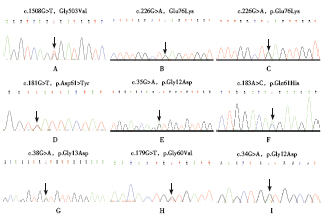 PDF(1280 KB)
PDF(1280 KB)


儿童幼年型粒单核细胞白血病突变基因型与临床特征分析
杨文钰, 陈晓娟, 王书春, 郭晔, 刘天峰, 常丽贤, 刘芳, 竺晓凡
中国当代儿科杂志 ›› 2015, Vol. 17 ›› Issue (1) : 1-5.
 PDF(1280 KB)
PDF(1280 KB)
 PDF(1280 KB)
PDF(1280 KB)
儿童幼年型粒单核细胞白血病突变基因型与临床特征分析
Gene mutations and clinical characteristics in children with juvenile myelomonocytic leukemia
目的 探讨儿童幼年型粒单核细胞白血病(JMML)突变基因类型及其临床特征.方法 回顾性分析临床诊断明确且完成JMML 常见突变基因检测的14 例患儿临床资料.结果 14 例JMML 患儿中,男11 例(79%),女3 例(21%).诊断时中位年龄2.0 岁(范围0.6~6.0 岁).14 例患儿中检出PTPN11 基因突变4 例(29%),N-RAS 基因突变3 例(21%),1 例同时伴有PTPN11 和K-RAS 基因突变(7%),6 例未检测到突变基因(43%).4 例PTPN11 基因突变患儿均为男性,中位发病年龄2.5 岁,从发病至明确诊断中位时间为1.0 个月,外周血WBC 计数及单核细胞绝对值明显增高,PLT 计数降低,随访至今3 例患儿死亡,1 例病情进展;3 例N-RAS 基因突变患儿男女比例为2: 1,中位发病年龄2.0 岁,从发病至明确诊断中位时间13.7 个月,随访至今2 例患儿死亡,1 例未见明显进展.结论 PTPN11 是JMML 最常见的突变基因类型,常伴有血WBC计数及单核细胞绝对值增高,PLT 计数降低,疾病进展迅速,预后不良;N-RAS 突变病例病情进展缓慢;复合突变基因类型由于病例数少,临床特征有待于临床进一步观察.
Objective To study gene mutations and clinical features in children with juvenile myelomonocytic leukemia (JMML). Methods The clinical data of 14 children who were diagnosed with JMML and were examined for the detection of common gene mutations were retrospectively analyzed. Results Eleven (79%) out of 14 cases were male, and 3 (21%) were female. The median age at diagnosis was 2.0 years (age range: 0.6-6.0 years). Among 14 cases, there were 4 cases (29%) with PTPN11 mutation, 3 cases (21%) with N-RAS mutation, 1 case (7%) with PTPN11 mutation and K-RAS mutation, and 6 cases (43%) without any mutation. All four cases in the PTPN11 mutation group were male, and their median age was 2.5 years; interval from onset to diagnosis was 1.0 month; the white blood cell (WBC) count and absolute monocytes in peripheral blood were significantly higher, while the platelet (PLT) count was lower, as compared with the other three groups; they were followed up, and 3 cases died and 1 case had a progressive disease. In the N-RAS mutation group, there were two male cases and one female case, and their median age was 2.0 years; interval from onset to diagnosis was 13.7 months; after follow-up, 2 cases died and 1 case did not have an obviously progressive disease. Conclusions PTPN11 mutation is the most common mutation in JMML. The cases with PTPN11 mutation often have higher WBC count and absolute monocytes in peripheral blood, a lower PLT count, and a rapid disease progression, and their clinical outcomes are poor. The cases with N-RAS mutation have a slow disease progression. The clinical characteristics of the patients with compound mutations are not sure because of the small number of cases, and further clinical observation is indispensable.

幼年型粒单核细胞白血病 / 突变基因 / 临床特征 / 儿童
Juvenile myelomonocytic leukemia / Gene mutation / Clinical characteristics / Child
国家自然科学基金(81300393,81300394).